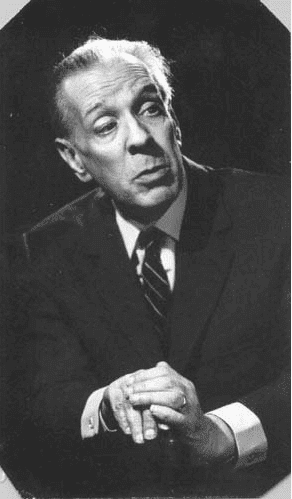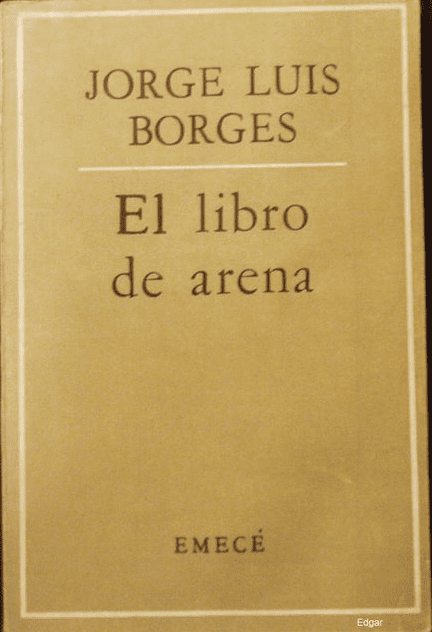Nicolas Roberto Robles
Badajoz, Spain
Penumbra de la paloma
llamaron los hebreos a la iniciación de la tarde
cuando la sombra no entorpece los pasos
y la venida de la noche se advierte
como una música esperada y antigua,
como un grato declive.
Twilight of the dove
the Hebrews called the initiation of the afternoon
when the shadow does not hinder the footsteps
and the coming of the night is noticed
like an expected and ancient music,
like a pleasant decline.
 |
| Figure 1. Jorge Luis Borges, 1967. Portrait by Annemarie Heinrich. Via Wikimedia. Public domain. |
Some of the most beautiful poetry of the twentieth century comes from Argentina, where Jorge Isidoro Francisco Luis Borges Acevedo was born on August 23, 1899. He was the son of Jorge Guillermo Borges—who also suffered of blindness—and of Leonor Acevedo. His maternal great-grandfather and paternal grandfather were military men, and his paternal great-grandfather was a writer and journalist. His paternal grandmother was also blind. He lived in Buenos Aires until 1914, when his father’s need for ophthalmic medical care moved the family to Geneva, Switzerland, for specialized medical treatment for an undefined disease.1 He returned to Argentina in 1921 to start his career as a poet.
Borges’ eye problems began at age nine when he presented with a refractive defect of vision, apparently myopia, characterized by a decrease in visual acuity and its correction with thick, “bottle-bottom” type glasses. At age nineteen, he was discharged from the army because of an “ocular condition.” At age twenty-eight, he was assessed by a specialist, who recommended surgical treatment. He underwent eight unspecified surgical operations between 1924 and 1954, presumably related to the ocular lens but saw no improvement to his condition. In fact, after the surgeries, his vision continued to worsen. By 1956, his eye doctors forbade him to read, and he became dependent on his mother and friends as readers and scribes. He reported total loss of vision in the right eye and partial loss in the left at the age of 77. He could only distinguish two of the three fundamental colors (dyschromatopsia), could not see in dim light or at night (nyctalopia), and had blurred vision.
In a lecture given at the Coliseo Theater in Buenos Aires on August 3, 1977, Borges mentioned that his blindness was total in one eye and partial in the other, and that he could see still yellow, along with green and blue, but that he missed the colors red and black.2
The vertical pattern transmission of his blindness suggests an autosomal dominant mode of inheritance. The blindness has an early onset, beginning in childhood and progressing painlessly for more than 80 years. It was characterized by dyschromatopsia-like manifestations, protanopia (insensitivity to red light, causing confusion of greens, reds, and yellows), and blurred vision, progressing to bilateral amaurosis (partial or complete loss of sight occurring especially without an externally perceptible change in the eye). It was accompanied by myopia, convergent strabismus of right predominance and predominantly right palpebral ptosis.
 |
| Figure 2. The Book of Sand. Photo by Edgarardiaca on Wikimedia. CC BY-SA 4.0.
|
It is important to emphasize the surgical history—eight operations, including cataracts and retinal detachment. The final diagnosis has not been established. The condition’s evolution suggests a proliferative myopia or “myopia magna,” a form of progressive myopia whose pathophysiology is unknown. The mode of inheritance of this ophthalmopathy is predominantly autosomal dominant, although to a lesser extent it can present as autosomal recessive or X-linked. In advanced cases, overgrowth of the eyeball may lead to strabismus. In addition, patients may present with opacity of the crystalline lens, which is compatible with the surgical procedures mentioned above. More importantly, it is known that it develops degenerative lesions of the peripheral retina, which predispose to serious complications such as retinal detachment, as described in the case.3
Borges died of hepatic cancer in Geneva on June 14, 1986, shortly after his marriage to Maria Kodama. His remains are in the Pleinpalais cemetery in that Swiss city. Writer of short stories, poems and essays, he is widely considered all over the world as a key literary figure. He inspired the key role of Jorge de Burgos in Umberto Eco’s “The Name of the Rose”:
Libre de la memoria y de la esperanza,
ilimitado, abstracto, casi futuro,
el muerto no es un muerto: es la muerte.
Free of memory and of hope,
limitless, abstract, almost future,
the dead man is not a dead man: he is death.
References
- García-Guerrero J, Valdez-García J, and González-Treviño JL. “La Oftalmología En La Obra Poética De Jorge Luis Borges (I).” Arch Soc Esp Oftalmol 2009;84:411–414.
- Borges JL. Siete noches: conferencia sobre su ceguera. México: FCE, 1980.
- De la Piedra Walter ME. “Diagnóstico etiológico de la ceguera de Jorge Luis Borges basado en su obra literaria.” Rev Mex Oftalmol 2017;91(4):188–194.
NICOLAS ROBERTO ROBLES is Professor of Nephrology at the University of Extremadura and Member of the Academy of Medicine.
Summer 2022 | Sections | Literary Essays

Leave a Reply